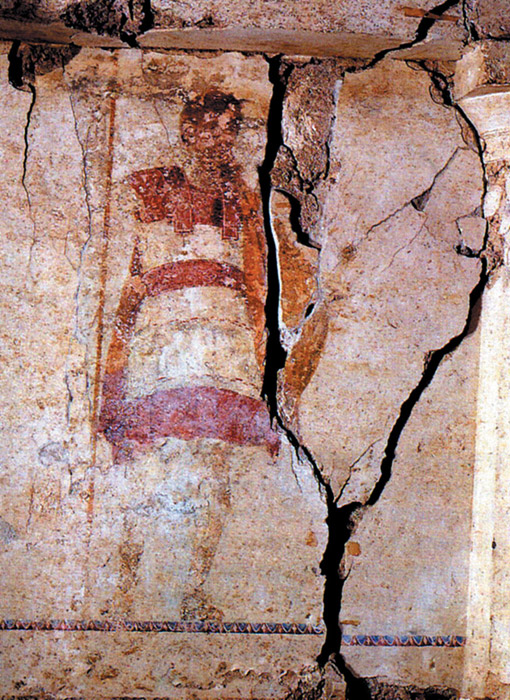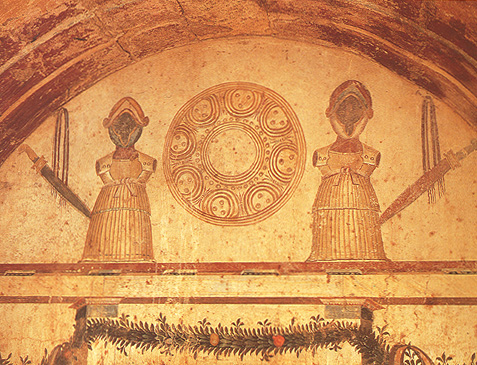The Cavalry and Officers
-
somatophylakes ("meaning bodyguards") were men that assisted the king maintain and run the army. There was 7 (later 8) during Alexander's time, but the Antigonid Kingdom may have employed 10 (this is strictly speculation, but Livy 34.52.5 mentions 10
clipea of silver at Flamininus’ triumph in Rome, perhaps a symbol of their high rank, or perhaps captured shields of Antigonid
hypaspistai equipped with similar shields to Alexander's
argyraspides, earlier titled
hypaspistai). Their signature weapon was the
xyston (Curtius 7.1.18) (in Alexander's era, but it's unclear if this still existed in the Antigonid period) and perhaps a silver gilded shield (as stated before, just speculation).
- the
basilikoi hypaspistai (meaning "royal shield-bearers") role is unclear in the Antigonid forces, but the title seems to be a lower rank of staff officers, perhaps acting as assistants to the higher ranking
somatophylakes. They did accompany the
basileus occasionally (Polybius 5.27.3) and seemed to be close to him, often acting as messengers (Polybius 18.33.2), so there must have been a considerable amount of them, maybe not enough for a field unit, furthermore there never was clear accounts of them on the field as a unit. They may have been equipped with a silver gilded shield (as stated in my previous point) as a badge of their rank.
- the cavalry were given crown lands by the
basileus, and they would offer military service and supply their own horse (Arrian Anabasis Alexandri 3.19.5), furnishing and equipment for their selves and the groom who accompanied him, from the resources of his estate. It seems to have been the responsibility of the state (at least in Alexander's time) to provide a remount for the cavalry if one died in action (Curtius 7.1.15). It is possible that Philip V had reformed the recruitment of the cavalry (see conscription diagramma of Philip V), admitting individuals into the arm through horse inspections (horses previously rejected being branded on the mouth with a
kerkeion). "a thousand drachmas for each horse" is mentioned; perhaps it's compensation from the state to the individual if their horse passed inspection for service (therefore, the stated owned the horse), or perhaps it's the individual paying compensation to the state to allow him to serve in the cavalry. This reform by Philip V does sound likely; the former system of service in return for land inevitably breaks down over time (eg. division of land from multiple son's inheritance), and it would explain how Philip V was able to increase the number of serving cavalry over threefold (see Sekunda 2010 & 2012).
- The cavalry was split into 2 distinct unit types, both Livy (42.58.6-9, 42.66.5, 44.42.2-3) and Polybius (4.37.7, 4.67.6) confirms this. Livy specifies the difference between "royal cavalry" (
basilikoi hippeis) and the "sacred squadron" (
hiera ilai) (42.58.6-9), while Polybius states that half the cavalry (400) were "about the Court" (4.67.6), but not further specifying what the other half was titled. Polybius describes the elite Ptolemaic cavalry in the same way (5.65.5), so it may be safe to conclude that the cavalry "about the Court" are the "sacred squadron" described by Livy, or perhaps the cavalry "about the Court" is a specific title given to an elite entity, and the "sacred squadron" being merely a component of it. Furthermore, Alexander's "royal squadron" (
basilikoi ilai) of
hetairoi also numbered 400 horses at the start of his reign (although later in his campaign, Alexander's
hetairoi were reduced to 300 horses).
- There doesn't seem to be evidence that an organised military unit of
hetairoi continued to be in use during Antigonid Makedonia, like Alexander's elite cavalry. It is likely that one of the units (mentioned in my previous point) was called
hetairoi by the Makedonians, but Polybius was Greek, and he probably would had stated if they were.
Hetairoi/philoi may have only continued as an honorific title, as the courtiers and close friends of the king in the Antigonid Kingdom. As stated before, Polybius' cavalry "about the Court" could be the same entity as Livy's "sacred squadrons", as Livy described these units accompanying the king in and out of the battle (44.42.4-3), and the
basileus taking position between the
agema peltastai and the "sacred squadron" in battle (Livy 42.58.9). There was a letter sent to King Demetrios II in 234/3 by a local citizen, Philoxenos: "
from the hetairoi of the chiliarchia of Philippos"; but the
chiliarchia was an infantry formation in Makedonian military history (inherited during Achaemenid rule), and their cavalry forces were never recorder to be near 1,000 men (a
chiliarchia) at the time of this letter (the highest being 800 (Polybius 4.37.7)).
- Apparently Makedonian cavalry (Hellenistic cavalry in general, actually) only started to use shields after the Celtic incursions (beginning 279 BCE).
- The cavalry reached a maximum strength of 800 horses (Polybius 4.37.7), but was raised to 3,000 during the 3rd Makedonian War (Livy 42.51.9).
The Infantry
- The regular soldiers of the army are referred to as
chalkaspides (Polybius 2.66.5),
hoplitai (Polybius 4.67.6, 4.69.4, Asclepiodotus Tacticus 1.2),
phalangites,
pezhetairoi (in Alexander's time at least, Arrian Alexander's Anabasis), and
sarissaphoroi. They were equipped with a
sarissa, a "small dagger" (Plutarch Aemilius 20.10) (Military Decree of Amphipolis mentions a
makhaira), a shield,
knemides (greaves), and a helmet. Body armour in the form of a
kotthybos was issued to all regulars of the phalanx except the
hegemons (officers and men of the front rank, perhaps the
lochagoi), which instead wore a
thorax and
hemithorakion (cuirass and semi-cuirass respectively) (see Military Decree of Amphipolis for these regulations). During the early Antigonid Kingdom they could be mustered to a strength of 10,000, by the end of the 3rd C they could consist of 16,000 men (done also by lowering the age requirement to 15 for the crisis), and by the end of Antigonid Makedonia they reached a strength of 21,000 men. The age requirement for these men may have been 22 (men up to the age of 22 seemed to have only trained with bow and javelin at the city's
gymnasiarchos).
- the
leukaspides are mentioned by Livy as fighting in a phalanx at the battle of Pydna (44.41.1-2), and Plutarch mentions Thracians in the exact same position as Livy's
leukaspides, but says they were equipped with
rhomphaias, white
thureoi and greaves, and wearing black tunics (Plutarch Aemilius Paulus 18.2). Diodorus mentions 1,200 wagons filled with "rough" white shields, and 1,200 wagons filled with bronze shields at the battle's triumph (31.8.10); in Plutarch's account, he mentions Thracian shields, instead of "rough" white shields (Plutarch Aemilius Paulus 32).
- The elite infantry were the
peltastai (also called
caetrati by Livy 42.51). They were equipped with a
sarissa (Plutarch Aemilius 19.1, also mentions them fighting in a phalanx) (shorter than that of the phalanx measuring only 12ft (Aelian 12), or they may have been equipped with a long spear (Asclepiodotus 1.2)), a sword (described as a "small
encheiridia" (Plutarch Aemilius 20.5)), a shield, and a helmet. No reference to greaves or cuirass. They could be mustered to a full size of 3,000 men, and this figure was sustained throughout Antigonid Makedonia (Livy 42.51.4-5, Polybius 4.29.1). The max age limit was 35 years old (see conscription diagramma of Philip V). The "best" recruits (most likely the wealthier and better educated citizens, ie.
euporoteroi) were recruited into the
peltastai, the rest into the regular phalanx.
- The
agema (perhaps also called
basilika syntagma, and nicknamed the "Conquerors" by Livy 43.19.11) were an elite contingent in the
peltastai (the
basileus taking position between the
agema peltastai and the "sacred squadron" in battle (Livy 42.58.9)). A difference in their equipment is not specified except that they had gilded weapons and wore crimson-dyed tunics (Plutarch Aemilius 18.3). The unit consisted of 2,000 troops throughout the time of the Antigonid Kingdom (Livy 42.51.4-5). This unit was comprised of the veterans of the
peltastai (Livy 42.51.4-5, Plutarch Aemilius18.3), with a max age limit of 45 (originally, but rose to 50 during the late Kingdom (see conscription diagramma of Philip V)).
- total strength of the
peltastai regiment (including the elite contingent of
agema) was always 5,000, and it's clear that when fewer men are mentioned in the texts (Polybius 2.65, 4.67.4, Livy 33.4.4-5, 44.32.6, Plutarch Aemilius 16.1) that the
agema served as the only
peltastai in the campaign, or that the
agema was excluded from the campaign, and "the other
peltastai" were the only ones included (numbers of 2,000 and 3,000
peltastai given on these occasions, respectively).
- the levy was mustered to a single location before individual units were formed from them, opposed to Alexander's method of recruiting region based regiments of the phalanx.
- men were registered to a city, where they were administered for liability of military service, trained, and levied.
- men younger than the age requirement of 20 for military service (the
epheboi), could be mustered in defense of the nation (not for campaigns outside national borders). This was usually only men of ages 18 and 19, but in a crisis, it could be as low as 15.
The Details of Arms, Armour, Equipment and Clothing
-
Sarrisa; in Alexander's time measuring 15-18ft (Theophrastus Historia Plantarum 3.12.1-2), Polybius (18.29.2) states an average of 22ft in his time, although he says was originally 26ft. The
sarrisa may have been lengthened during the Diadokhoi wars, because the phalanx would loose a lot of its effectiveness if out-reached. Polybius (18.29.3-4) also says 2/7 of the length of the
sarissa was placed behind the wielder, and the other 5/7 protruding in front, and that it was held with both hands (Plutarch Aemilius 20.4).
- Makedonian shields; 2 different sizes have been identified, the one believed to be relevant to the phalanx is ~74cm in diameter, Reinach making this connection and calling it the
chalkaspis. The second is referred to as a
pelte, measuring ~66cm in diameter, which is believed to have been used by the
elite peltastai.
- Cavalry shields; 2 popular forms existed in Hellenic cavalry forces, both circular and 1 metre in diameter, wooden, and sometimes covered in leather or felt. 1st was reinforced with a large metallic umbo in the centre. 2nd was reinforced by a "barleycorn"-shaped umbo over a spina centered across the front (like that depicted on the Aemilius Paullus Monument at Delphi). Latter seems to only have become popular during the 2nd C.
- Helmets; Alexander regularly distributed pilos helmets (aka.
konos or
lakonian) during the last few years of his reign, and seems to have been the norm by the end of the 3rd C (see Military Decree of Amphipolis).
-
Kotthybos; unsure exactly what this is, but probably a light armour constructed from linen and/or leather; may translate to "Egyptian armour/girdle"?






 Reply With Quote
Reply With Quote










